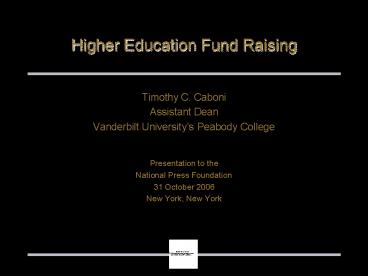Higher Education Fund Raising - PowerPoint PPT Presentation
1 / 19
Title:
Higher Education Fund Raising
Description:
Higher Education Fund Raising – PowerPoint PPT presentation
Number of Views:135
Avg rating:3.0/5.0
Title: Higher Education Fund Raising
1
Higher Education Fund Raising
- Timothy C. Caboni
- Assistant Dean
- Vanderbilt Universitys Peabody College
- Presentation to the
- National Press Foundation
- 31 October 2006
- New York, New York
2
Beginning Questions
- Is an appropriate volunteer fund raising board in
place, and do its members fully understand their
leadership role and responsibilities? - Has your institution systematically examined its
fund raising potential? - Is the development office appropriately organized
and configured for optimum productivity and
results? - Has your institution made the prerequisite
investments in institutional advancement to
attain the desired results? - Does the President play an appropriate role in
leading the fund raising program and integrating
it into the institutions superstructure?
3
Pyramid of Giving
- PLANNED GIVING
- Bequests
- Wills/Legacies
- Estate Gifts
- Net Worth Gifts
Investment
Donor Commitment
- MAJOR GIVING
- Endowment Campaigns
- Capital Campaigns
- Special Projects
- From Individuals/Corporations Foundations
Involvement
Donor Growth
Interest
- ANNUAL GIVING TO/FROM I.E.
- Support Groups
- Special Events and Benefits
- Annual Campaigns
- Direct Mail Program
- The general public
Information
Initial Support
Identification
4
5
(No Transcript)
6
(No Transcript)
7
Gift Pyramid
- 60 of gifts come from 10 of donors
- 15-25 of gifts come from 20 of donors
- 15-25 of gifts come from 70 of donors
8
(No Transcript)
9
(No Transcript)
10
Building and Maintaining the Base
- Acquisition mailings Enlist new donors Never
Givers - Renewals produce income (sybunts, lybunts)
- First time givers renew at 50 rate, after
that, 70-80 - 50 or your returns come in the first week
11
Pyramid of Giving
- PLANNED GIVING
- Bequests
- Wills/Legacies
- Estate Gifts
- Net Worth Gifts
Investment
Donor Commitment
- MAJOR GIVING
- Endowment Campaigns
- Capital Campaigns
- Special Projects
- From Individuals/Corporations Foundations
Involvement
Donor Growth
Interest
- ANNUAL GIVING TO/FROM I.E.
- Support Groups
- Special Events and Benefits
- Annual Campaigns
- Direct Mail Program
- The general public
Information
Initial Support
Identification
12
Stages in the cycle
1 Identification 2 Research 3 Planning 4
Cultivation 5 Solicitation 6 Stewardship 7 Renewal
13
Principles of Gift Charts
- The first two gifts should equal 10 of the goal
100,000 - The next four gifts equal an additional 10 of
the goal 100,000 - The remaining gifts are flexible and can be
broken down into various categories 800,000. - This chart is most effective with fundraising
goals of 25,000 or more
14
1M Gift Table
15
Efficiency vs. Effectiveness
Difference between effectiveness (maximizing the
net between total gifts less fund raising costs)
and efficiency (minimizing the average cost per
dollar raised) The objective of an institution's
fund-raising program should not be to spend as
little as possible each year to raise money, but
to maximize the net.
16
Efficiency vs. Effectiveness
A program that annually produces 2 million at a
cost of 160,000, or 8 percent, may look good and
is indeed efficient, but one that produces 3
million at a cost of 300,000, or 10 percent, is
presumably of more help to the institution i.e.,
more effective -- it is bringing in 860,000
more.
17
Return on Investment Analysis
- ROI Funds raised as a percentage of fund
raising expenses - Bottom line cost percentages are not a useful
measurement for internal management purposes - Performance of one kind of fund raising program
cannot be evaluated against others
18
ROI Analysis
19
Contact Information
- Timothy C. Caboni
- Vanderbilt Universitys Peabody College
- Box 514
- Nashville, TN 37203
- 615-343-6222
- tim.caboni_at_vanderbilt.edu
- peabody.vanderbilt.edu/faculty/lpo/caboni.htm































